Post by Bluthardt on Jun 1, 2010 1:51:30 GMT -5
Velociprey

Velociprey are a very common raptor-like species. They have blue scales with black stripes, and a dull red and black monocrest on the top of their heads. These carnivorous creatures travel in packs and inhabit many different landscapes.
They have a larger, more ferocious leader named the Velocidrome.
An experienced hunter should have no trouble dealing with them, though a new hunter will have some trouble against these fierce opponents. Velociprey are capable of leaping great distances, making them difficult to flee from, especially when delivering eggs and large ores. They sometimes will be slashed in two when struck by a strong weapon (such as a fully charged Greatsword) or when sliced in midair (eg. Longswords). When this happens the Velociprey will disappear when it lands and it cannot be carved.
Velocidrome
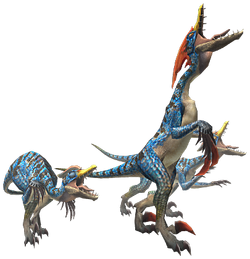
A Velocidrome is the alpha male leader of a Velociprey pack. Its large, bright red crest over its blue hide signifies to other Velociprey that it is fit to be their leader, and is. In the original Monster Hunter, Velocidromes were always surrounded by Velociprey which constantly spawns and, more often than not, hunters had to face at least 2 of them in one quest
Genprey
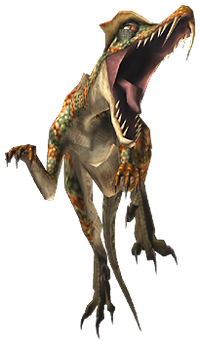
Genprey are a Bird Wyvern species that inhabit Swamps and Deserts. They are also found in the Great Forest and Gorge. They possess a colorful yellow and green hide and a yellow crest. Like all the carnivorous preys, these hunters travel in packs. Genprey are the second strongest of the prey subspecies. They are very similar to Velocipreys and Iopreys, having basically the same moves, but of course with paralysis abilities.
Their fangs contain a paralysis inducing neurotoxin, and can be combined with a Trap Tool to create a Shock Trap. By living in the harsh terrain of the deserts, evolution has made them tougher than the Velociprey. They are also more accurate in attacks, and can inflict more damage.
Gendrome
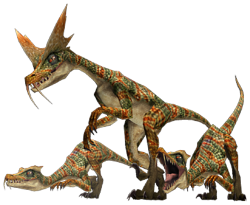
Gendromes are the pack leaders of the Genprey. Their dual-crest and two protruding fangs signalize their leadership. Although they are physically the second strongest of all prey dromes, they are typically the most feared because of their ability to paralyze hunters. They are a good source of Paralysis Sacs for hunters.
With a pack to protect them and paralyzing fangs, they are a force to be reckoned with. Considerably harder than a Velocidrome, Gendrome pose a challenge to novice hunters. Quick attacks and high speed allow it to attack with suprising power. Contrary to popular belief dromes aren't always male. Female dromes do exist in the same way that males do, except they do all of the reproducing and rear all of the younger pack members or future pack leaders.
Ioprey
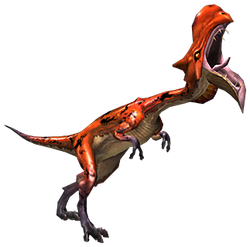
Ioprey are a Velociprey subspecies that inhabit jungle, swamp, fortress and volcanic zones, they can also be spotted in the great forest region in MHFU and Frontier. They are covered in a red hide with black spots. Their lower body is white. They possess large heads, containing Poison Sacs in their throat. In Monster Hunter and in Monster Hunter Freedom poison sacs can be carved from these blood-thirsty monsters. The Ioprey's cries are quite different than the other "preys", sounding a bit more dragonlike. Ioprey has a much more amphibian look than the other "preys" due to the salamander-like skin that constantly needs moisture and the frog-like throat sac. This might explain why a major amount of Ioprey live in the swamp. They might also migrate to the swamp to prevent dehydration.
Iopreys are the largest of all the prey species. Due to living in the most unforgiving habitats, they evolved to become the most dangerous and strongest prey of all. They travel in packs and have the ability to spit poison. The duration of the poison effect varies depending on the rank of the Ioprey, as does the efficiency of the poison. For instance, a G-rank Ioprey's poison lasts much longer than a low rank one's and is more harmful.
Iodrome
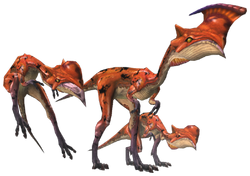
Iodromes are the alpha males of the Ioprey. They are significantly larger and possess larger crests. They travel with their pack for protection. When threatened, Iodromes spew poison from their throat sacs. Unlike the other prey-dromes, the Iodrome has a more amphibian look, with salamander-like skin that needs moisture, and frog-like throat sacs.
Being the strongest of all the prey dromes, the Iodromes are the perfect challenge to hunters. Although not as strong as wyverns, they can quickly cripple hunters with the power of numbers and poison. Iodrome is a threat to new hunters with their speed, agility and high strength compared to the other prey dromes.
As with all other 'dromes, they are an irritation to any hunter trying to hunt a larger monster.
Jaggi
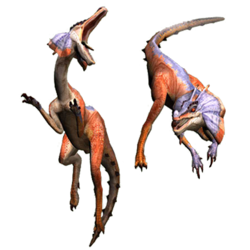
Jaggi are young male members of the Jaggi family, a Bird Wyvern subspecies, and something of a parallel to the "Prey" species of other regions, though notably smaller in size. At this stage in development, Jaggi are mostly orange, with blue foreclaws, back-stripe, and head-frills, and with cream-colored underbellies. Their tails are barbed along the length of the appendage, and they sport sizable frills sprouting from behind their jaws.
Other members of the Jaggi family include the larger female Jaggia, and the pack-leading alpha male Great Jaggi.
Though Jaggi and their kin display a higher functioning level of cooperation than other Raptors, Jaggi are often easily dealt with, even for novice hunters. This is due, in part, to their boisterous nature; Jaggi will often spend just as much time vocalizing bark-like warnings against intruders as they will attacking them.
Great Jaggi

The Great Jaggi is a monster featured in Monster Hunter 3. It is larger than previous Dromes. It has a long, barbed tail and large frills on the sides of its head. Unlike previous Dromes, the Great Jaggi gives three carves instead of two.
Great Jaggi, along with the Great Baggi, may attack other boss monsters instead of focusing solely on the hunter, indicating a highly competitive and intelligent demeanor. It can also summon Jaggi at any time with a loud, resonating roar. Being a larger and more powerful version of Jaggi and Jaggia, it is considered by players to be the boss of these monsters. Its alpha status is much more prominent than that of previous Dromes, as it features many of the characteristics of full-fledged boss monsters—the ability to become enraged, limping when weak, and having a breakable part.
One should note that the Great Jaggi can be summoned by the Qurupeco at the Deserted Island or the Sandy Plains.
Baggi

Baggi are small blue Bird Wyverns from the Tundra in Monster Hunter 3. They are generally commanded by an alpha male or alpha female known as a Great Baggi. They have the ability to put other creatures to sleep by using its special liquid spit. Baggi have the same attacks as the creatures they resemble, the Jaggi, but attack more without delay. They will spend much less time hissing and will rush at hunters without warning.
Baggi cannot jump down ledges. They behave the same way as Jaggi and Jaggia when hunters have out and/or hit them with a torch.
Great Baggi

The Great Baggi is a Bird Wyvern of the Tundra in Monster Hunter 3. Its moveset is generally similar to the Great Jaggi, although harder to kill overall. Its eyes will glow in the dark. Unlike the Jaggi, it is not sexually dimorphic and can be either the Alpha Male or Female of a pack. Great Baggi is also slightly larger than the Great Jaggi. As with the Giadrome, Iodrome and Gendrome, it has developed its own unique ability to spit a liquid that inflicts sleep on its prey or hunters. Smaller Baggis are also able to spit a weaker form of this liquid. Located on its head is a crest that can be obtained in a way similar to Great Jaggi's frill. Great Baggi and Great Jaggi are often seen to be hostile towards other boss monsters; when in the same area they will occasionally cease fighting the hunter and attack another monster.

Velociprey are a very common raptor-like species. They have blue scales with black stripes, and a dull red and black monocrest on the top of their heads. These carnivorous creatures travel in packs and inhabit many different landscapes.
They have a larger, more ferocious leader named the Velocidrome.
An experienced hunter should have no trouble dealing with them, though a new hunter will have some trouble against these fierce opponents. Velociprey are capable of leaping great distances, making them difficult to flee from, especially when delivering eggs and large ores. They sometimes will be slashed in two when struck by a strong weapon (such as a fully charged Greatsword) or when sliced in midair (eg. Longswords). When this happens the Velociprey will disappear when it lands and it cannot be carved.
Velocidrome

A Velocidrome is the alpha male leader of a Velociprey pack. Its large, bright red crest over its blue hide signifies to other Velociprey that it is fit to be their leader, and is. In the original Monster Hunter, Velocidromes were always surrounded by Velociprey which constantly spawns and, more often than not, hunters had to face at least 2 of them in one quest
Genprey

Genprey are a Bird Wyvern species that inhabit Swamps and Deserts. They are also found in the Great Forest and Gorge. They possess a colorful yellow and green hide and a yellow crest. Like all the carnivorous preys, these hunters travel in packs. Genprey are the second strongest of the prey subspecies. They are very similar to Velocipreys and Iopreys, having basically the same moves, but of course with paralysis abilities.
Their fangs contain a paralysis inducing neurotoxin, and can be combined with a Trap Tool to create a Shock Trap. By living in the harsh terrain of the deserts, evolution has made them tougher than the Velociprey. They are also more accurate in attacks, and can inflict more damage.
Gendrome

Gendromes are the pack leaders of the Genprey. Their dual-crest and two protruding fangs signalize their leadership. Although they are physically the second strongest of all prey dromes, they are typically the most feared because of their ability to paralyze hunters. They are a good source of Paralysis Sacs for hunters.
With a pack to protect them and paralyzing fangs, they are a force to be reckoned with. Considerably harder than a Velocidrome, Gendrome pose a challenge to novice hunters. Quick attacks and high speed allow it to attack with suprising power. Contrary to popular belief dromes aren't always male. Female dromes do exist in the same way that males do, except they do all of the reproducing and rear all of the younger pack members or future pack leaders.
Ioprey

Ioprey are a Velociprey subspecies that inhabit jungle, swamp, fortress and volcanic zones, they can also be spotted in the great forest region in MHFU and Frontier. They are covered in a red hide with black spots. Their lower body is white. They possess large heads, containing Poison Sacs in their throat. In Monster Hunter and in Monster Hunter Freedom poison sacs can be carved from these blood-thirsty monsters. The Ioprey's cries are quite different than the other "preys", sounding a bit more dragonlike. Ioprey has a much more amphibian look than the other "preys" due to the salamander-like skin that constantly needs moisture and the frog-like throat sac. This might explain why a major amount of Ioprey live in the swamp. They might also migrate to the swamp to prevent dehydration.
Iopreys are the largest of all the prey species. Due to living in the most unforgiving habitats, they evolved to become the most dangerous and strongest prey of all. They travel in packs and have the ability to spit poison. The duration of the poison effect varies depending on the rank of the Ioprey, as does the efficiency of the poison. For instance, a G-rank Ioprey's poison lasts much longer than a low rank one's and is more harmful.
Iodrome

Iodromes are the alpha males of the Ioprey. They are significantly larger and possess larger crests. They travel with their pack for protection. When threatened, Iodromes spew poison from their throat sacs. Unlike the other prey-dromes, the Iodrome has a more amphibian look, with salamander-like skin that needs moisture, and frog-like throat sacs.
Being the strongest of all the prey dromes, the Iodromes are the perfect challenge to hunters. Although not as strong as wyverns, they can quickly cripple hunters with the power of numbers and poison. Iodrome is a threat to new hunters with their speed, agility and high strength compared to the other prey dromes.
As with all other 'dromes, they are an irritation to any hunter trying to hunt a larger monster.
Jaggi

Jaggi are young male members of the Jaggi family, a Bird Wyvern subspecies, and something of a parallel to the "Prey" species of other regions, though notably smaller in size. At this stage in development, Jaggi are mostly orange, with blue foreclaws, back-stripe, and head-frills, and with cream-colored underbellies. Their tails are barbed along the length of the appendage, and they sport sizable frills sprouting from behind their jaws.
Other members of the Jaggi family include the larger female Jaggia, and the pack-leading alpha male Great Jaggi.
Though Jaggi and their kin display a higher functioning level of cooperation than other Raptors, Jaggi are often easily dealt with, even for novice hunters. This is due, in part, to their boisterous nature; Jaggi will often spend just as much time vocalizing bark-like warnings against intruders as they will attacking them.
Great Jaggi

The Great Jaggi is a monster featured in Monster Hunter 3. It is larger than previous Dromes. It has a long, barbed tail and large frills on the sides of its head. Unlike previous Dromes, the Great Jaggi gives three carves instead of two.
Great Jaggi, along with the Great Baggi, may attack other boss monsters instead of focusing solely on the hunter, indicating a highly competitive and intelligent demeanor. It can also summon Jaggi at any time with a loud, resonating roar. Being a larger and more powerful version of Jaggi and Jaggia, it is considered by players to be the boss of these monsters. Its alpha status is much more prominent than that of previous Dromes, as it features many of the characteristics of full-fledged boss monsters—the ability to become enraged, limping when weak, and having a breakable part.
One should note that the Great Jaggi can be summoned by the Qurupeco at the Deserted Island or the Sandy Plains.
Baggi

Baggi are small blue Bird Wyverns from the Tundra in Monster Hunter 3. They are generally commanded by an alpha male or alpha female known as a Great Baggi. They have the ability to put other creatures to sleep by using its special liquid spit. Baggi have the same attacks as the creatures they resemble, the Jaggi, but attack more without delay. They will spend much less time hissing and will rush at hunters without warning.
Baggi cannot jump down ledges. They behave the same way as Jaggi and Jaggia when hunters have out and/or hit them with a torch.
Great Baggi

The Great Baggi is a Bird Wyvern of the Tundra in Monster Hunter 3. Its moveset is generally similar to the Great Jaggi, although harder to kill overall. Its eyes will glow in the dark. Unlike the Jaggi, it is not sexually dimorphic and can be either the Alpha Male or Female of a pack. Great Baggi is also slightly larger than the Great Jaggi. As with the Giadrome, Iodrome and Gendrome, it has developed its own unique ability to spit a liquid that inflicts sleep on its prey or hunters. Smaller Baggis are also able to spit a weaker form of this liquid. Located on its head is a crest that can be obtained in a way similar to Great Jaggi's frill. Great Baggi and Great Jaggi are often seen to be hostile towards other boss monsters; when in the same area they will occasionally cease fighting the hunter and attack another monster.
